
About UsThe Numismatic Bibliomania Society is a non-profit organization promoting numismatic literature. For more information please see our web site at coinbooks.org SubscriptionsThose wishing to become new E-Sylum subscribers (or wishing to Unsubscribe) can go to the following web page link MembershipThere is a membership application available on the web site Membership Application To join, print the application and return it with your check to the address printed on the application. Membership is only $15 to addresses in the U.S., $20 for First Class mail, and $25 elsewhere. For those without web access, write to: David M. Sundman, Secretary/TreasurerNumismatic Bibliomania
Society AsylumFor Asylum mailing address changes and other membership questions, contact David at this email address: dsundman@LittletonCoin.com SubmissionsTo submit items for publication in The E-Sylum, just Reply to this message, or write to the Editor at this address: whomren@coinlibrary.com
BUY THE BOOK BEFORE THE COINYou won't regret it! |
- WAYNE'S WORDS: THE E-SYLUM JUNE 20, 2010
- DIX NOONAN WEBB DAVID GRIFFITHS LIBRARY SALE RESULTS JUNE 16, 2010
- JOEL L. MALTER ANCIENT ART LIBRARY SALE OCTOBER 16-17, 2010
- NEW BOOK: A BIBLIOGRAPHY OF 18TH CENTURY NUMISMATIC BOOKS
- NEW BOOK: THE AUTHORITATIVE REFERENCE ON THREE CENT SILVER COINS
- BOOK REVIEW: INDIAN GOLD COINS OF THE 20TH CENTURY BY MIKE FULJENZ
- NEW BOOK: THE MAN WHO LOVED BOOKS TOO MUCH
- DENNIS TUCKER ON THE HISTORY OF THE RED BOOK
- OLD BOOK: THE PRESS-WORKING OF METALS BY OBERLIN SMITH
- MORE ON THE MYSTERY NUMISMATIST OF 1885
- QUERY: CHASE MANHATTAN MONEY MUSEUM VISITORS CIRCA 1945
- MORE ON THE VARIOUS U.S. MINT BUILDINGS
- A GERMAN COLLECTOR'S CABINET FROM 1630
- MORE ON THE DIANA GAMES OF CHANCE TWENTY DOLLAR GOLD PIECE
- QUERY: BASHLOW CONFEDERATE COIN RESTRIKE SIX-COIN SETS
- QUERY: WEALTH OF THE SOUTH TOKEN IMAGES SOUGHT
- QUERY: JUDGE JAMES P. GORTER MEDALLION SOUGHT
- THE LIBRARY OF COINS ALBUMS AND THE COIN AND CURRENCY INSTITUTE
- MORE ON COIN STRIKING TECHNOLOGY
- BILL ECKBERG ON THE NEIL-CARTER 1794 DOLLAR
- MORE ON THE 2010 BOSTON ANA MEDAL FEATURING PAUL REVERE
- TRUTH IN LABELING NEEDED FOR PRINT ON DEMAND LISTINGS
- DICK JOHNSON ON HOW THE MERCATOR MAP MEDAL COULD BE REPRODUCED
- BALDWIN'S TO SELL PART II OF THE MICHAEL HALL MEDAL COLLECTION
- NOTES FROM E-SYLUM READERS: JUNE 20, 2010
- KENT COMPANY PROTOTYPE COIN BOARDS DISCOVERED
- QUERY: WHAT IS THIS STRANGE 'GOOD LUCK' SYMBOL?
- 2010 WORLD CUP COMMEMORATIVE COINS
- THE WORLD'S LARGEST GOLD COIN TO BE AUCTIONED
- ARTICLE HIGHLIGHTS BANK OF VANCOUVER SERIAL NO. 1 BANKNOTE
- VIDEO: COIN CONNECTED TO ROBERT SCOTT SOUTH POLE EXPEDITION
- AN INTERVIEW WITH U.S. MINT DIRECTOR EDMUND MOY (PART II)
- WAYNE'S NUMISMATIC DIARY: JUNE 20, 2010
- BIBLIOPULP: PULP FICTION STYLE POSTERS FOR BIBLIOMANIACS
- FEATURED WEB SITE: IRISH COINAGE
WAYNE'S WORDS: THE E-SYLUM JUNE 20, 2010

Among our new subscribers this week are Frank Murphy, Ed Craig, Len Cicero, Bill Lenz, Millard Hajek and Joe Burford, all courtesy of Russ Sears, Scott Enterline, Ann Filsinger, Tom Masbruch, and Anil J Patel. Welcome aboard! We now have 1,359 subscribers.
Many thanks to Russ Sears for his big subscriber recruiting effort! Thanks also to Bill Eckberg, who helped recruit a few subscribers with a notice in his EAC Region 8 newsletter. And... Happy Father's Day, Dads!
This week we open with some numismatic literature sale results from Dix Noonan Webb, an announcement of another Joel Malter library sale, and information on FOUR new books of interest to numismatists and bibliophiles.
Other topics addressed this week include the history of the Red Book, Jerry Fochtman's mystery numismatist, and a beautiful collector's cabinet from 1630. Queries include visitors to the Chase Manhattan Bank Money Museum, Wealth of the South tokens, and a strange-looking good luck symbol.
To learn about the world's largest gold coin, Schenkman-48, the use of kerosene in striking coins, and the night the Charlotte Mint was destroyed by fire, read on. Have a great week, everyone!
Wayne Homren
Numismatic Bibliomania Society
DIX NOONAN WEBB DAVID GRIFFITHS LIBRARY SALE RESULTS JUNE 16, 2010
Just thought I'd fill you in with some of the results from our 16 June auction of numismatic books:
Total realised for 69 lots 21,235 GBP (US $31,425), almost double the top estimate.
Lot 312, Gibson, E., Camden's Britannia, Newly Translated into English, Oxford, 1695, $3,900
Lot 328, Seaby's Coin & Medal Lists, London, various issues, 1929-1951, $3,730
Lot 329, Seaby's Coin & Medal Lists, 1936-1940, almost complete, $3,730
Lot 310, The British Numismatic Journal, 1904-1988, complete, $2,130
Lot 336 Spink's Numismatic Circular List, March 1940-December 1943, complete, $2,130
Lot 335, Spink's Numismatic Circular, 1892-1939, complete, $980
Lot 330, Seaby's Coin & Medal Bulletin, 1952-1990, complete, official binding, $925
Our next auction of books is on October 6th, featuring the David Griffiths reference library of token literature.
JOEL L. MALTER ANCIENT ART LIBRARY SALE OCTOBER 16-17, 2010
John and Nancy Wilson of Ocala, FL write:
Of interest to E-Sylum readers is the fall sale of the Malter library somewhere around Encino, CA. Read about the sale in The Celator. Besides looking at the sale online (see link below), you can order the catalog at the below address. Costs are $10 for USA address, and $25 International.
The Joel L. Malter Ancient Art Library “One of the best privately owned libraries of its type anywhere in the world” To be held on Saturday and Sunday, October 16th and 17 th, 2010. Malter Galleries Inc., 17003 Ventura Bl. Suite 205, Encino, California 91316 U.S.A, Phone 818-784-7772, Fax 818-784-4726, Email, mike@maltergalleries.com, www.maltergalleries.com Auction online site: http://maltergalleries.com/jlmartlibrary.pdf
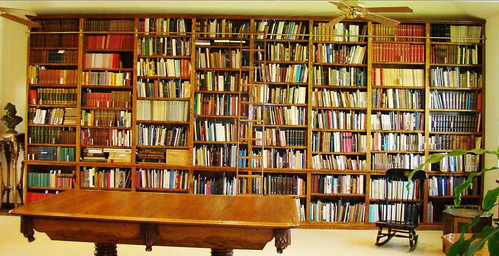
Joel Malter's life can be defined in one word, passion. Whether it was teaching 9th grade world history back in the 1960‟s in Los Angeles, running one of the most successful ancient coin companies in the world in the 1970‟s and 80‟s, or assembling one of the finest privately held numismatic and ancient art libraries, my dad did it with gusto! I spent 20 years of my youth growing up in the same house and then rolled that into a career of 30 more years working and traveling the world with my dad, suffice it to say, I knew him very well. Back in June of 2006 my dad made a huge decision and decided that as his 75 birthday was on the horizon, it was time to sell his prized numismatic library.
You see these were not just old coin books that he and the company used to write up our ancient coin auctions, no these were his pride and joy. Family was always first with my dad, but boy how he enjoyed buying and buying books. He wanted the 2006 auction to be something special. Not just another one of our numerous auctions, but this was to be a crown jewel of crown jewels. It took several months back in 2006 to put the coin book auction together and when it was finally finished, no one was happier than my dad.
That hot June day back in 2006, coin dealers and collectors from all parts of the US and several from abroad were all sitting in his home library as the auction began. It was a great auction. Prices for his coin books went sky high! It was a great day! The auction ended with the “buzz” around the room being total amazement at the fierce bidding and ridiculously high prices that his books realized. I know that my dad was pleased with the results but also sad at the same time. I knew that his heart was broken to see his cherished books leave his library.
The next morning I got a call from my mom in the middle of the night. As I picked up the phone and heard her voice I just knew that something horrible had happened. My dad died shortly after the paramedics arrived, unable to restart his broken heart.
My mother Adele and the rest of the Malter family are extremely proud and honored to offer the second and final portion of my dad's beloved library on October 16th and 17th. As was the case with his numismatic books, his ancient art books were carefully collected and purchased with passion! The overall condition of the library is excellent, with many of the books custom bound in museum quality bindings. One on the last things that my dad said to me just after the coin book auction ended in 2006, was “even though the numismatic book as now gone, we still have the better portion of the library”. That being said, I also remember him saying to me on more than one occasion, “no one really owns anything, we just take care of it while we can”. It was a family decision to put his ancient art books on the auction block at this time.
This is a fantastic opportunity to purchase and “take care” of my dad's books which will now become your books. Specialized libraries such as this are seldom offered in this quality and quantity. Over 50 years of buying and searching out for the rarest and the best are offered in this auction. I believe that it would be impossible to start today and assemble the same library that is offered herein. There's a book in this sale for even the most specialized of ancient art lovers. Study this catalogue carefully and good luck with your bidding!
Michael G. Malter
To view the auction catalog, see: maltergalleries.com/jlmartlibrary.pdf
NEW BOOK: A BIBLIOGRAPHY OF 18TH CENTURY NUMISMATIC BOOKS
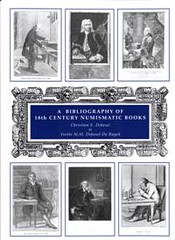 Now available.Volume I : Introduction - A-B - All indexes for the 5 volumes : 1212 pages, illustrations title-pages throughout. Casebound in cloth, gilt, dust jacket. London, SPINK 2010. Limited to 100 copies.
Now available.Volume I : Introduction - A-B - All indexes for the 5 volumes : 1212 pages, illustrations title-pages throughout. Casebound in cloth, gilt, dust jacket. London, SPINK 2010. Limited to 100 copies.
Forthcoming volumes:
Volume II : C-GN : 1256p.
Volume III : GO-L : 1368p.
Volume IV : M-R : 1372p.
Volume V : S-Z : 1236p.
Early numismatic publications contain invaluable evidence which can throw new light upon unsolved numismatic questions. This is the starting point and the 'raison d'être' of this major new series of books which cover all authored numismatic publications from 1700 till 1800, excluding all numismatic publications concerning the French Revolution which will be the subject of a separate publication..
For more than 200 years the main bibliographic source for identifying early numismatic publications was the Bibliotheca Numaria, published by J.G. Lipsius in 1801.
During the last fifty years Christian E. Dekesel and his wife Yvette M.M. Dekesel-De Ruyck have not only identified, but also analysed page by page these 18th century publications, enabling them to expand the Lipsius bibliography of 18th century publications to no less than 6,500 items, many unknown to Lipsius and his predecessors.
The first volume explains the research strategy and also contains a detailed geographical, chronological, and categorical analysis of all 18th century numismatic publications. It also contains several indexes covering the 5 volumes which makes consulting the bibliography so much easier.
The rest of the first volume and the other four following volumes consist of an alphabetical catalogue of all 18th century numismatic books which have been located and analysed, excluding all non-identifiable secondary references from other bibliographies.
Each book has been the subject of a detailed bibliographic analysis, an 'autopsy' as the authors have termed it. No less than 8785 illustrations accompany the entries.
All entries are categorized under eleven headings, each dealing with a different aspect of the numismatic field.
- 1. Publications about the coins or medals themselves, their physical appearance, their relationship, and/or their place in a historical context.
- 2. Publications concerning monetary aspects, dealing with theoretical problems, metallurgical content, political constellation, legal consequences and the economical situations.
- 3. Publications concerning weights and measures, their use in coinage, and for other purposes, e.g. medicinal, trade, etc.
- 4. Ordinances, edicts, placards and coin-books used by money-changers as long as they have an author clearly mentioned on the title-page
- 5. Numismatic bibliographies and catalogues of libraries with a large proportion of numismatic entries.
- 6. Moral and religious dissertations on coins and money, their use and abuse.
- 7. Travel books with a numismatic content.
- 8. Publications on antique gems, rings, amulets, hieroglyphs and inscriptions with a strong connection to coins and medals.
- 9. Portrait books which have taken their inspiration from coins and medals or vice-versa.
- 10. Biographies of numismatists.
- 11. General historical publications containing numismatic references.
The heart of this remarkable book is the alphabetical catalogue, the index is its soul. The authors have thought long and hard on behalf of potential users of this new book. The indexes, which form part of the first volume, cover an extensive bibliography of 18th century publications in general, authors, editors, translators, printers, publishers, places and dates of publication, categories, subjects, and libraries with 18th century numismatic publications, and make it possible to search for a specific book from different angles.
Lipsius remained the standard numismatic bibliography of early numismatic books for more than 200 years - Christian Dekesel and Yvette M.M. Dekesel-De Ruyck's Bibliographic Opus is destined to replace it.
Biographical Dictionaries for 16th and 17th Centuries also available.
£135.00
To visit the Spink web site, see: www.spink.com
NEW BOOK: THE AUTHORITATIVE REFERENCE ON THREE CENT SILVER COINS
I wrote to Kevin, and he provided the following information. -Editor
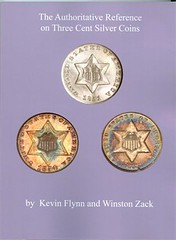 The book titled “The Authoritative Reference on Three Cent Silver Coins” by Kevin Flynn and Winston Zack is now available. This book is 197 pages, 8 ½ by 11, and many photographs. This book will only be printed in soft cover. Price is $44.95. Include $5 for shipping media rate, $10 for first class. We will only be printing about 250 copies.
The book titled “The Authoritative Reference on Three Cent Silver Coins” by Kevin Flynn and Winston Zack is now available. This book is 197 pages, 8 ½ by 11, and many photographs. This book will only be printed in soft cover. Price is $44.95. Include $5 for shipping media rate, $10 for first class. We will only be printing about 250 copies.
Up to now, there has been no book just on this series. The primary purpose of this book was to create a complete and comprehensive reference for the Three cent silver series including all major die varieties, history, hub changes, collecting, historical documents, and hot topic such as the early proofs and an analysis of each of the overdates which were listed for this series.
The die variety section of the book includes a complete listing of the known doubled dies, repunched dates and RPMs, including several new die varieties which have not been listed before. For each die variety listed, detailed macro photos make identification much easier. Most of the varieties include multiple photographs showing different details. Included also for each variety is a detailed description of the variety, diagnostics, including die markers such as die cracks, scratches, clashes which can make identifying the variety easier, pricing, and cross references.
Many new archive letters were uncovered relative to the Three cent silver series and are included. This greatly helped in the analysis of the history section and shed new details on the series. For each hub change, enlarged photos show the before and after of the design changes with a detailed description of the differences A section on Three cent silver coins is also included with a detailed descriptions for each grade.
This book also contains three sections written by Jonathan Lerner, one of the foremost experts on the series.
The Three cent silver counterfeit section contains a complete analysis and many examples of counterfeits found in this series. The Three cent silver patter section contains a complete analysis of all patterns of this series
The date-by-date section offers an analysis of each date including scarcity, striking characteristics, world history which occurred that year, hot topics, comments, current values, prices realized from Heritage Auctions, and the certified population counts from PCGS and NGC. Many years also include the number of working dies struck for that year. For the early years, 1851 through 1857, the estimated number of proof coins is included.
Sections are included which cover collecting Three cent silver coins, certified Three cent silver coins, and cleaned Three cent silver coins. Two cool Three cent silver errors are included.
The Hot Topics section contains a several detailed studies on the Three cent silver series including an analysis of early Three cent silver proofs, the 1858 Three cent silver design changes, and the declining mintages of the Three cent silver series. A complete analysis is done on each of the overdates which were listed in the Three cent silver series, refuting each of them.
Price is $44.95, include $5 for postage for media mail, $10 for priority mail. To order a copy, send a check or money order to Kevin Flynn, P.O. Box 396, Lumberton, NJ 08048. For any questions, please send to kevinj50@comcast.net
BOOK REVIEW: INDIAN GOLD COINS OF THE 20TH CENTURY BY MIKE FULJENZ
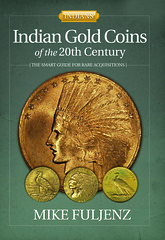 A new book by award-winning numismatic author Mike Fuljenz, Indian Gold Coins of the 20th Century, looks at the history of the popular Indian Head design $2.50 ("Quarter Eagle"), $5 ("Half Eagle") and $10 ("Eagle") denomination gold coins, and provides useful information and expert advice for collecting some of America's most beautiful and popular rare coins.
A new book by award-winning numismatic author Mike Fuljenz, Indian Gold Coins of the 20th Century, looks at the history of the popular Indian Head design $2.50 ("Quarter Eagle"), $5 ("Half Eagle") and $10 ("Eagle") denomination gold coins, and provides useful information and expert advice for collecting some of America's most beautiful and popular rare coins.
A detailed, date-by-date analysis with color illustrations gives readers pertinent descriptions about the history of each date and mintmark as well as important comments about strike, luster, color and eye appeal. Fuljenz includes Overall Rarity and Uncirculated Rarity rankings tabulated from Numismatic Guaranty Corporation and Professional Coin Grading Service population reports for grades MS62 to MS65. There also are consumer education tips about protecting coins from theft, and the best ways to sell gold coins.
Fuljenz examines the intriguing historical background and the controversies involved in the introduction of revolutionary new U.S. gold coin designs spurred by President Theodore Roosevelt in the early 20th century. The first production of Indian Head $10 coins in 1907 and early 1908 did not contain the motto, IN GOD WE TRUST, until Congress legislated its return.
"Teddy Roosevelt launched an artistic renaissance in American coin design that swept across all denominations," Fuljenz explains early in the 258-page book. "Roosevelt made no secret of his contempt for the colorless drudges at the U.S. Mint headed by chief engraver Charles E. Barber. Barber's designs exhibited all the excitement of a cold, soggy bowl of oatmeal."
The President turned to acclaimed artists Bela Lyon Pratt and Augustus Saint-Gaudens to create new coin designs. Pratt designed the Quarter Eagles and Half Eagles minted from 1908 to 1929, and Saint-Gaudens created the design for Eagles produced from 1907 to 1933 (as well as the iconic $20 Double Eagle design of 1907 to 1933 that collectors today simply refer to as "Saints" in his honor).
Fuljenz writes: "Winning a mandate to the presidency on his own merit in the 1904 election, Roosevelt was emboldened to commit what he called his 'pet crime' of transforming United States coinage to a state of pride and respect even if it meant trampling roughshod over the established inbred Washington political cliques."
A frequent interview guest on radio and television news and personal finance programs, Fuljenz is President of Universal Coin & Bullion, Ltd. in Beaumont, Texas and serves on the Board of Directors of the Industry Council for Tangible Assets. He is the recipient of 30 national awards from the Numismatic Literary Guild.
Published by Subterfuge Publishing, Indian Gold Coins of the 20th Century by Mike Fuljenz (ISBN:10-0981948898) has a suggetsted retail price of $14.95. Copies are available by calling toll-free at (800) 877-3273.
- Quarter eagles ($2.50) 1908-1929
- Half Eagles ($5.00) 1908-1929
- Eagles ($10.00) 1907-1933
It's nicely designed and illustrated with large color photos throughout. The Foreword by Ed Reiter notes that the author had previously written separate books on the Indian Eagle and Quarter Eagle. "Now he has updated the contents of those two books and combined them in a single volume, along with totally new text on the third 20th-century coin..."
That note explains my main puzzlement in first reading the book - the sense of déjà vu as the story of how the assassination of McKinley thrust the young Teddy Roosevelt into the Presidency, already nicely explained in pages 1-3, was rehashed in different words on pages 37-38.
The book was published by "Subterfuge Publishing, Where Everything is Not Always As It May Seem", according to their web site at http://www.subterfugepublishing.com/.
I think the book is fine for its intended purpose - an introduction and guide for purchasers of these coins. The date-by-date analysis discusses the mintage and availability of each coin in various uncirculated grades, typical wear spots, luster and coloration. As a dealer Fuljenz has experience handling large quantities of these coins, and solicited input from other dealers as well, including Doug Winter, Scott Travers and Paul Montgomery.
The main drawbacks I see with the book could have been addressed with better editing. The repetition of the McKinley story is just one example - there are several things that I think another editor would have addressed immediately, beginning with the title itself. "Indian Gold Coins of the 20th Century" is an ambiguous title that could be referring to coins of the Indian subcontinent as easily as those of the U.S. Although plenty of numismatic books have this problem, it would have been easy to clarify by prefixing the title with "United States."
A less obvious problem, but a glaring one for bibliophiles is the misspelling of Reiter's Foreword as "Forward". It's an understandable error and easy to make, but it looks bad when appearing in a printed work.
Some sections of the book just don't seem to belong. I suppose there are reasons to include two pages on "7 Different Places to Quickly Sell Your Gold Coins and Jewelry", but the last chapter (titled "Identity Matters") discusses such far-afield topics as the Buffalo Nickel, the 1918 Illinois Centennial Half Dollar and "The French Origins of the Dixies and the Dimes."
Ordinarily I tend to peruse a new book from back to front, first checking for the presence of a detailed bibliography and notes indicating the level of research done by the author. I didn't do that this time, but I was taken aback by what I found when I got there. The book does have a bibliography, but of the approximately 90 entries, over 80 are web pages (including The E-Sylum archives). The few actual books cited include the Breen Encyclopedia, the Garrett/Guth gold coin encyclopedia, Coin World Almanac, and the "Red Book."
Wait a minute. I rechecked the bibliography. No mention of Roger Burdette's Renaissance of American Coinage. No book on the topic of early 20th Century U.S. coinage should be written without consulting Burdette's RAC.
E-Sylum readers will have varying opinions (and I'd love to hear them) about the use of Internet resources. I use them myself all the time, and as time goes on more and more primary sources will become available on the web. But even in 2010, primary sources are limited online, and books that rely primarily on Internet research are necessarily derivative.
In summary, this is a book for readers who want an introduction to the series, but it's not the place to expect groundbreaking archival research (or even references to groundbreaking archival research). And I guess that's OK - there is room for all types of books in the numismatic sphere. I just won't discard my set of Burdette to make room on the shelf for this one. -Editor
NEW BOOK: THE MAN WHO LOVED BOOKS TOO MUCH
George Fuld writes:
Though not on numismatic books, a new true story book might be of interest. Allison H. Bartlett's "The Man Who Loved Books Too Much" refers to our word "bibliomania" repeatedly.
 The book was published in 2009 and is available online. I took the cover image from Amazon, as well as this synopsis from Publisher's Weekly:
The book was published in 2009 and is available online. I took the cover image from Amazon, as well as this synopsis from Publisher's Weekly:
Bartlett delves into the world of rare books and those who collect—and steal—them with mixed results. On one end of the spectrum is Salt Lake City book dealer Ken Sanders, whose friends refer to him as a book detective, or Bibliodick. On the other end is John Gilkey, who has stolen over $100,000 worth of rare volumes, mostly in California. A lifelong book lover, Gilkey's passion for rare texts always exceeded his income, and he began using stolen credit card numbers to purchase, among others, first editions of Beatrix Potter and Mark Twain from reputable dealers.
Sanders, the Antiquarian Booksellers' Association's security chair, began compiling complaints from ripped-off dealers and became obsessed with bringing Gilkey to justice. Bartlett's journalistic position is enviable: both men provided her almost unfettered access to their respective worlds.
Gilkey recounted his past triumphs in great detail, while Bartlett's interactions with the unrepentant, selfish but oddly charming Gilkey are revealing (her original article about himself appeared in The Best Crime Reporting 2007). Here, however, she struggles to weave it all into a cohesive narrative. (Sept. 17) Copyright © Reed Business Information, a division of Reed Elsevier Inc. All rights reserved.
To read more on Amazon, see: The Man Who Loved Books Too Much: The True Story of a Thief, a Detective, and a World of Literary Obsession (www.amazon.com/Man-Who-Loved-Books-Much/dp/1594488916/)
THE BOOK BAZARRE
DENNIS TUCKER ON THE HISTORY OF THE RED BOOK
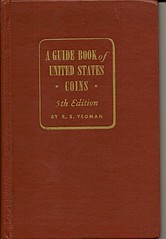 A quick note about Susan Headley's article on Red Book collector Scott White: the first edition of the Red Book was actually published in November 1946, not in 1947. It was so late in the year that Whitman decided to give the book a 1947 cover date. Since that time, out of both tradition and necessity, the Red Book has had a cover date one year ahead of the chronological year.
A quick note about Susan Headley's article on Red Book collector Scott White: the first edition of the Red Book was actually published in November 1946, not in 1947. It was so late in the year that Whitman decided to give the book a 1947 cover date. Since that time, out of both tradition and necessity, the Red Book has had a cover date one year ahead of the chronological year.
The 1965 edition, also mentioned in the article, was actually published in 1964, rather than 1965. With 1,200,000 copies sold, that particular edition ranked ahead of Dale Carnegie's How to Win Friends and Influence People and John F. Kennedy's Profiles in Courage. I know a lot of this is old history for many E-Sylum readers, but I wanted to mention it for the record.
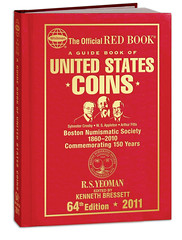 Incidentally, Ms. Headley is one of my favorite numismatic writers. I enjoy the "personality profiles" she's done on various numismatic folks, and her early coverage of China's modern-day counterfeiting factories was groundbreaking.
Incidentally, Ms. Headley is one of my favorite numismatic writers. I enjoy the "personality profiles" she's done on various numismatic folks, and her early coverage of China's modern-day counterfeiting factories was groundbreaking.
I would be remiss if I didn't remind E-Sylum readers about Frank Colletti's Guide Book of the Official Red Book of United States Coins, a history book and price guide for collecting Red Books. The autographed, limited-edition leatherbound volume has long since sold out, but the regular softcover can be found online, in bookstores, and through numismatic booksellers.
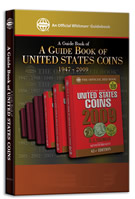 It's a fun read, chock full of numismatic bibliomaniacal history, and with more stories than the Empire State Building.
It's a fun read, chock full of numismatic bibliomaniacal history, and with more stories than the Empire State Building.
To read the earlier E-Sylum article, see: ARTICLE SPOTLIGHTS RED BOOK COLLECTOR SCOTT WHITE (www.coinbooks.org/esylum_v13n24a08.html)
OLD BOOK: THE PRESS-WORKING OF METALS BY OBERLIN SMITH
(I should also note that this Numismatist issue also has a nice Letter to the Editor by Eric von Klinger commenting on an earlier piece about the fanciful "Josh Tatum" story an the 1883 "Racketeer" nickel. Eric cites Patrick Feaster's February 25, 2007 submission to The E-Sylum which pretty thoroughly debunks this myth and traces the origins to a 1965 newspaper article by Maurice Gould). -Editor
Oberlin Smith, Press-Working of Metals. A Treatise Upon the Principles and Practice of Shaping Metals in Dies By the Action of Presses, Together with a Description of the Construction of Such Implements in Their Various Forms and of the Materials Worked In Them John Wiley & Sons, New York, 1896

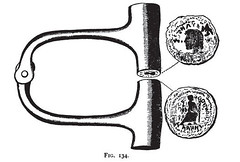
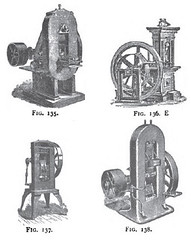
To read the book on Google Books, see: Press-Working of Metals
MORE ON THE MYSTERY NUMISMATIST OF 1885
Last week Jerry Fochtman wrote:
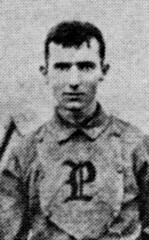 I've attached a picture of a young man who later in life wrote a couple of milestone books on numismatics. This photo shows him as a member of a local softball team that was called the Pioneers and I doubt few have seen this.
I've attached a picture of a young man who later in life wrote a couple of milestone books on numismatics. This photo shows him as a member of a local softball team that was called the Pioneers and I doubt few have seen this.
Next week I'll send a picture of this person later in life, which will probably surprise a lot of folks..... but chances are he still won't be well recognized, although his name is well known.
James Higby writes:
The mystery numismatist looks like Abe Kosoff to me.
Pete Smith writes:
The photo gives no clue to the identity of the mystery numismatist. So I ask, where do the interests of Jerry Fochtman and Benny Bolin intersect? The answer I come up with is ...
Jerry Fochtman writes:
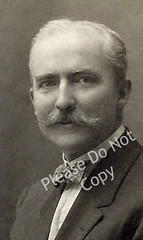 This photo of the same numismatist was circa 1905-1910 as near as I've been able to determine. The distant family member who had it didn't know who he was until I identified him for them. I estimated the time frame based upon a picture of other family members that was taken at the same time and portrait studio. He hadn't yet established a reputation in numismatic circles.
This photo of the same numismatist was circa 1905-1910 as near as I've been able to determine. The distant family member who had it didn't know who he was until I identified him for them. I estimated the time frame based upon a picture of other family members that was taken at the same time and portrait studio. He hadn't yet established a reputation in numismatic circles.
QUERY: CHASE MANHATTAN MONEY MUSEUM VISITORS CIRCA 1945
Gene Hessler writes:
Here is a photo of Vernon Brown, surrounded by young collectors. I wonder if anyone can identify those in the picture taken at the Chase Manhattan Money Museum circa 1945 when Vernon was curator. The boy on Vernon's left resembles Richard Margolis.
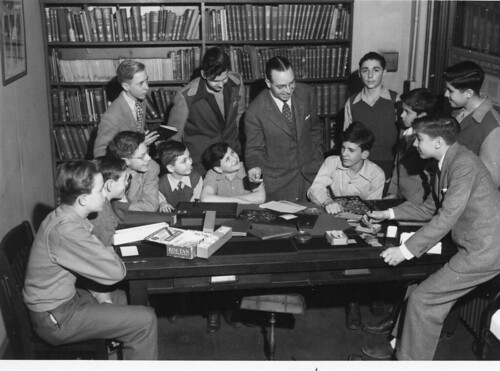
MORE ON THE VARIOUS U.S. MINT BUILDINGS
Pete Smith writes:
It was the second San Francisco Mint that survived an earthquake in 1906, not the third as you show in The E-Sylum. Based on your response about the columns of the (second) third Philadelphia Mint, I suspect that some people find this area confusing.
Bob Neale writes:
Regarding Mark Borckart's list of mint buildings, allow me to comment regarding the following from Mark and to update my total to 18 facilities.
Mark wrote:
15. The Denver Mint of Clark, Gruber was intended to be operated as a United States Mint, although the government produced no actual coins at that facility.
16. The U.S. Assay Office in San Francisco, operated by Augustus Humbert absolutely qualifies
17. The “Fugio” Mint where the 1787 Fugio cents were produced.
Also, we could add "Harper's cellar" to the list for the 1792 half dismes...
If the Charlotte Mint burned down before coinage began (and I have never heard of that before) was rebuilt, was it also reauthorized? If not, then it doesn't count as two, only as one. The only southern mint that burned down, to the best of my knowledge, was Dahlonega, but that was long after coinage ended.
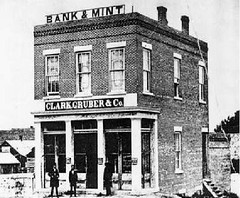 [1] Re the Denver Mint: If the authorizing bill of 19 December 1861 did indeed authorize the striking of coinage, then Mark is surely correct. The Government bought the Clark & Gruber private mint building and equipment for $25K and opened it 24 September 1863 as a US Mint & Assay Office. Since 'Mint' is in the title, it probably should have been included in the list. So, 2 facilities for Denver.
[1] Re the Denver Mint: If the authorizing bill of 19 December 1861 did indeed authorize the striking of coinage, then Mark is surely correct. The Government bought the Clark & Gruber private mint building and equipment for $25K and opened it 24 September 1863 as a US Mint & Assay Office. Since 'Mint' is in the title, it probably should have been included in the list. So, 2 facilities for Denver.
[2] If Humbert's 1851 SFO assay office (Moffat & Co) was titled as a provisional mint, as noted in the Red Book, I guess the $50 pieces should be considered official coinage. Thanks, Mark.
[3] I don't count the 1787 Fugios because there was as yet no U.S. Government and Congress under the Constitution. But I should have framed my question more carefully.
[4] Harper's Cellar wasn't a facility authorized by Congress, was it? It was just convenient.
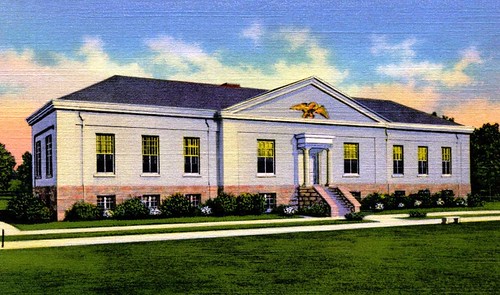
[5] The Charlotte Mint was authorized 3 March 1835, minted coins 1838-1844, burned down in 1844, rebuilding was authorized by Congress 3 March 1845, and minting resumed October 1846. So I took it as two facilities.
On the night of July 27, 1844, it was nearly destroyed by fire, which occurred in the coining room, and nearly consumed the entire building. The machinery was seriously injured but the records being stored in the vault, were not injured. Mr. Caldwell, the superintendent, reported that evidently the fire was the work of a thief, as his living apartments had been entered and articles stolen.
The present building was authorized by an act of March 3, 1845, and was completed at a cost of $31,572.97, and occupied in 1846, and used for coinage purposes until May 20, 1861, when North Carolina entered the Confederacy and operations were suspended. The building was used during the Civil War as a Confederate hospital.
Well, on Friday afternoon I gave George a call and had a very pleasant conversation. The columns we've been looking for have been in storage since the mid-1990s, first in the Philadelphia area after they'd been removed from the Einstein Hospital grounds, then in New Jersey following the company's move.
His company is the go-to contractor for the movement and installation of large artworks in the Philadelphia region. Most columns of this sort are built in sections and held together with pins, but these impressive columns are each a single piece of stone. They stood at the entrance of the second Philadelphia Mint from 1833 to about 1904.
The Einstein Hospital is exploring possible new uses for the columns, and George will keep us informed of new developments. Meanwhile, these interesting architectural artifacts will remain in safe storage (not that anyone is going to make off with them in a pickup truck). -Editor
To read the earlier E-Sylum article, see: QUIZ ANSWER: HOW MANY DIFFERENT U.S. MINT BUILDINGS? (www.coinbooks.org/esylum_v13n24a12.html)
A GERMAN COLLECTOR'S CABINET FROM 1630
Harry Waterson writes:
I don't know if The E-Sylum technology is up for it, but this a collector's cabinet of rare fineness.
It's very well done - a great example of using technology to its fullest to present a "better than being there" museum experience. In the real world one isn't allowed to touch the artifacts, but in this virtual world visitors can spin the cabinet around, open drawers and poke around the contents. Check it out - it cool! -Editor

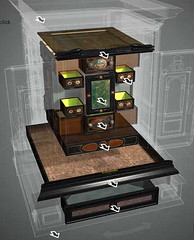
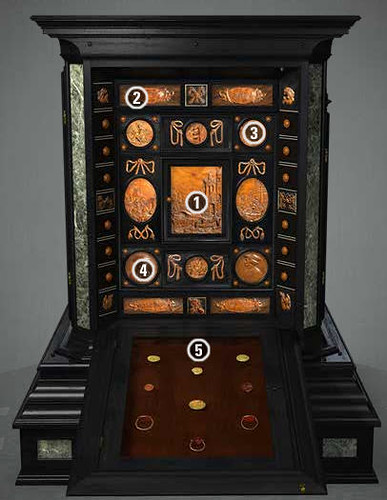
Called a Kabinettschrank ("display cabinet" in German), this type of furniture is also referred to as a cabinet of curiosities or wonders. It was conceived to store items of artistic, natural, and intellectual interest.
Created in about 1630, this example from Augsburg, Germany was probably designed by the merchant-collector Phillipp Hainhofer, who customized it according to the interests of its intended, but now unknown, owner.
To visit the Getty web page, see Augsburg Display Cabinet (www.getty.edu/art/exhibitions/north_pavilion/cabinet/index.html)
THE BOOK BAZARRE
MORE ON THE DIANA GAMES OF CHANCE TWENTY DOLLAR GOLD PIECE
Dick Doty of the National Numismatic Collection writes:
Regarding the Diana Gambling token, it seems to me that a token is defined as a substitute for ‘real' money. As such, it will be made from a lesser or at least different material than the money whose substitute it is intended to be. Why would anyone create a gambling chip of the same size, weight, and material as the coin it's intended to replace?
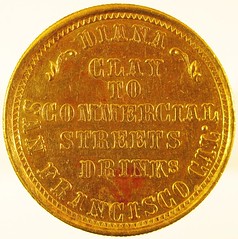

Harvey Stack writes:
Your follow-up report in last week's E-Sylum was great. It gave both sides of the discussion (which was reported and argued since John Ford, and ourselves, defended the accusations and discoveries in the 1950s).
I was trying to promote research and greater numismatics by study and reading and not depending on simple Guidebook information. We both agree, I am sure, that more research is being done today to make numismatics more interesting and exciting than was done within the past half century. I picked an unusual subject to write about because of the history it had, and the effort made to explain the reason for its existence. Your publication really encourages research and greater understanding about the hobby we all love.
To read the earlier E-Sylum article, see: ON THE DIANA GAMES OF CHANCE TWENTY DOLLAR GOLD PIECE (www.coinbooks.org/esylum_v13n24a16.html)
To read Harvey's original essay, see: HARVEY STACK ON THE VALUE OF BOOKS (www.coinbooks.org/esylum_v13n23a09.html)
QUERY: BASHLOW CONFEDERATE COIN RESTRIKE SIX-COIN SETS
I've been following with interest the articles on the Bashlow Confederate Cent 2nd restrikes. I have a six coin set in a 74mm x 150mm Capital plastic holder – three of the Bashlow cents and three of the Confederate half dollar in bronze, silver, and goldine.
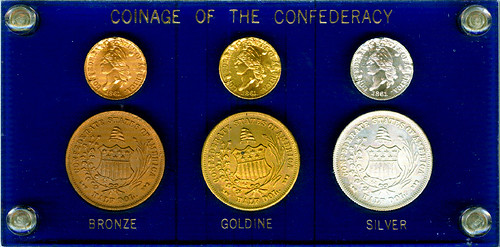
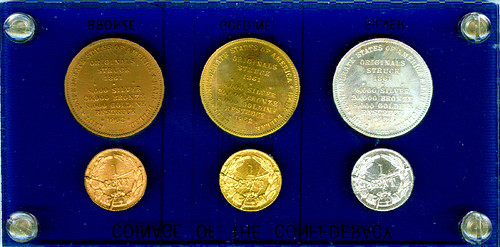
I've only seen three over the years and haven't been able to find out anything about it. I did, however, correspond about it with Harold Levi (author of “THE LOVETT CENT; A CONFEDERATE STORY”). Mr. Levi also has a set and noted that he had only seen four of the sets over the years (one of which was an image of mine that I sent him).
He also noted that another source informed him he'd seen less than six. Assuming none of these “sightings” are duplicates (except Mr. Levi's inclusion of my set), that's a total of 12 sets. Has anyone else seen one of these?
QUERY: WEALTH OF THE SOUTH TOKEN IMAGES SOUGHT
I have a third volume in my “Little Greybook” series well underway with the working title “Confederate Coins, Medals, Badges, and Ribbons – Part 1: Forerunners to 1889”. Hopefully it'll cover the period from just before the War Between the States, through the war years, and end just before the formation of the United Confederate Veterans in 1890. In this connection I respectfully solicit your readers for possible appropriate material for inclusion. I presently have some 150 or so images but am always looking for more.
At the moment I'm actively seeking three images from the “Wealth of the South” token series, namely: Fuld TN-600E, STEAMER LANCASTER NO. 4; Fuld TN-600F, STOCKMAN & CO, MEMPHIS; and Fuld OH-165AMb EXCELSIOR TOBACCO WORKS.
Also, might anyone possibly know how to contact Daniel Hartzler, author of “A Band of Brothers – Marylanders in the Confederacy”. Alternatively if anyone has images of Maryland Confederate Cross badges, please, please let me hear from you. Many thanks in advance for any assistance.
QUERY: JUDGE JAMES P. GORTER MEDALLION SOUGHT
James Polk Gorter was born on August 27, 1858. He attended school at Charles M. Maguire's school in Baltimore, Anne Arundel County Academy (1871-2), St. John's College Preparatory Department (1872-4), and received his B. A. at St. John's College. In 1877, he received his L. L. B. degree at the University of Maryland Law School. St. John's college awarded him a Master of Arts degree in 1881 followed by a L. L. D. degree in 1912.
Gorter studied law with Alexander H. Hagner in 1878. He became a public school teacher and taught in Annapolis from 1879-80. Returning to law, he joined the law practice of H. Arthur Stump and Henry D. Harlan. In 1891, he served in the Maryland State Senate. He became Baltimore City Attorney from 1892-96 before serving as Baltimore City Collector from 1899-1903.
His first appointment to the bench was in 1907 when he was made an Associate Judge of the Supreme Bench of Baltimore City. He continued in that position until 1922 when he was promoted to Chief Judge in which job he stayed until his retirement in 1928. He died in 1939. Source: Archives of Maryland.
At the time of his retirement, the Baltimore legal community formed a committee to have a medallion made as a thank you for Judge Gorter. The head of The Judge Gorter Medallion Committee was Charles Harley, a leading attorney. He contracted with Baltimore jeweler Carl Schon to make one gold and one bronze medallion at a total cost of $ 425.00.
Ordinarily we write articles about tokens, medals and related exonumia. We have never seen the Gorter medals, but own the bill from Carl Schon. This bill was in the files of what was once the law practice of Charles Harley. When the firm ceased to exist, a local man assembled the files and offered the various papers to local collectors.
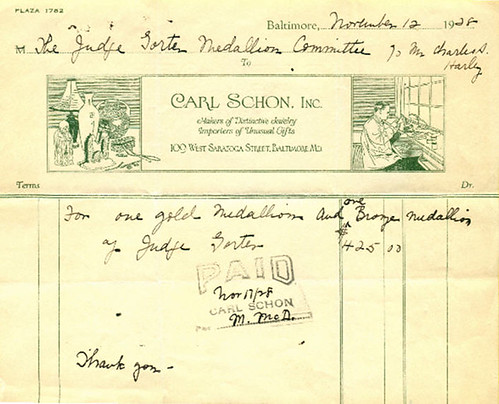
THE LIBRARY OF COINS ALBUMS AND THE COIN AND CURRENCY INSTITUTE
James Higby writes:
Regarding the Library of Coins question, this is a scan of the back page of a 1969 copyrighted album for type coins.
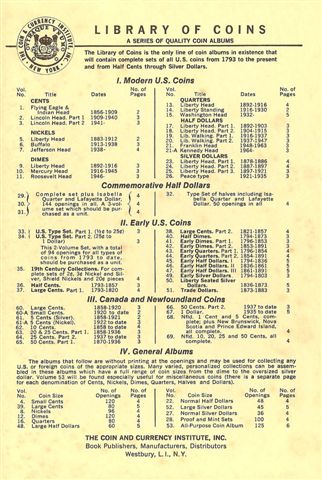
So here's another quiz for our readers - at least eight numismatic books (some appearing in multiple editions) have been published by The Coin and Currency Institute, Inc. What are they? -Editor
To read the earlier E-Sylum article, see: NOTES FROM E-SYLUM READERS: JUNE 13, 2010 (www.coinbooks.org/esylum_v13n24a18.html)
MORE ON COIN STRIKING TECHNOLOGY
Dick Hanscom provided this update on his coin striking experiments:
I did another experiment with the drop hammer, pushing it down the runners. Almost got a full strike. I need to make arrangements to really throw it down. I am sure that will do the trick. Sledge hammer did even better, but I wimped out and didn't hit it as hard as I could have for fear of missing!
I played with the new screw press. It punches out blanks (so far up to 32mm, 2.4mm thick for my trial strikes with the drop hammer) and will strike a 14mm token. I'll progress up to see how large it will go with one twirl of the swing arm (I am sure there is a technical name).
Jim Duncan writes:
I'm a collector, not an engineer, but I once watched a man using a drop hammer. Every time, just before he dropped the hammer, he painted the top of the upper die with something. I asked what it was, and the answer was "kerosene". He reckoned he got an extra bit of 'push' as the kerosene exploded under the impact. I can't answer for the efficacy of it, just that he did do it, and reckoned it worked.
Dick Hanscom adds:
Kerosene....hmmmm.... I think my wife thinks I am enough of a danger to myself without adding an explosive. May have to try it.
Dick Johnson writes:
I am waiting for Dick Hanscom to get so frustrated with his home minting kit that he is going to throw something against the wall.
Dick, take your die to a professional private mint and have them strike it for you. They will know what to do and have the proper equipment to do it. I just hope you haven't received your mail order home heart surgery kit yet.
Eric Holcomb writes:
I've already been in communication with Dick, and we've worked out a simpler version of the calculation for his book that uses English units from the outset.
This is actually a very interesting and complex problem. As it turns out, Dick has some good hydraulic press data that show why it's difficult to get a good single strike for a coin or token of this size (1 oz. gold), due to work hardening of the metal. As I pointed out, that's what the U.S. Mint discovered in 1907 for the high-relief double eagles. Would a “hot strike” be more successful? – that would be interesting to know.
To read the earlier E-Sylum article, see: MORE ON COIN STRIKING PRESSURE CALCULATIONS (www.coinbooks.org/esylum_v13n24a13.html)
BILL ECKBERG ON THE NEIL-CARTER 1794 DOLLAR
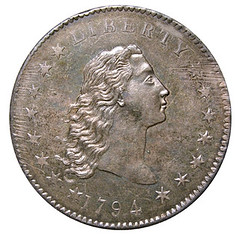 Thanks to David Ganz for providing his numbers behind his graph of the price history of this coin. The (very minor) differences from my findings are due to his calculating the rate of return for each individual sale, whereas my graph uses a statistical analysis to show the history of the fair market value of the coin. As we all know, the actual sales prices of coins usually vary from what we would call the fair market value.
Thanks to David Ganz for providing his numbers behind his graph of the price history of this coin. The (very minor) differences from my findings are due to his calculating the rate of return for each individual sale, whereas my graph uses a statistical analysis to show the history of the fair market value of the coin. As we all know, the actual sales prices of coins usually vary from what we would call the fair market value.
Sometimes we get good deals, and sometimes we get bad deals. Nevertheless, you can see from his numbers that the rates of return are remarkably consistent, with only the 1986 sale at a loss as a minor outlier. While the numbers vary, numbers of this kind ALWAYS vary, which is why so many statisticians have jobs. The fit is surprisingly - even exceptionally - close, and quite remarkable because of it.
I guess I'll also stir the pot and annoy more people who subscribe to the notion that coin was the "first". There is, in fact, no pedigree for the coin that goes back to anyone who was alive at the time the coin was struck. Therefore, it cannot possibly be known where this coin came among those issued.
Accepting opinions that it is in an early state, we can guess that it was probably among the first several hundred. That the blank was first drilled and plugged would seem to me evidence that nothing about that planchet or coin was considered special at the time. If it were being handled specially as "The First", you'd think they'd have been able to dig out a better planchet. If it was really a "specimen" of what the dollar was to look like, the exact weight might not even have been an issue.
In any case, let's not forget that the Mint had already struck a few hundred thousand cents and half cents before it got around to that one. The Mint was a workshop, and these coins that we carefully preserve and minister to today are a lot more important to us than they ever were to anyone in the Mint in the 18th century. There is no evidence that even the first Chain AMERI, which we know had to be the first real coin struck by the Mint, was saved or that we could identify it today, even if we wanted to. There is also no evidence that the first of any other variety was preserved.
Dick Doty is absolutely correct in considering speculation about this coin being the first silver dollar struck to be in the realm of theology, not history and certainly not logic. But, hey, if it gives anyone pleasure and fulfillment to worship at the altar of this coin, go for it. My opinion is of little consequence.
To read the earlier E-Sylum articles, see:
MORE ON THE 1794 DOLLARS
(www.coinbooks.org/esylum_v13n23a17.html)
MORE ON THE 1794 DOLLAR RATE OF RETURN
(www.coinbooks.org/esylum_v13n24a14.html)
MORE ON THE 2010 BOSTON ANA MEDAL FEATURING PAUL REVERE
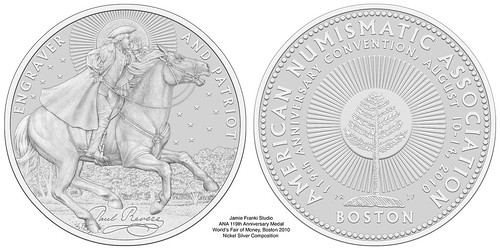
"The obverse horse and rider are excellent, but the halo and rays around Revere's head are incongruous. Paul Revere is not a Saint and these attributes are reserved for saints and religious people.
"The reverse design is less than mediocre. The tree is too small, too symmetric, the rays surrounding it are too numerous. The design is overwhelmed by the rays. Overall it is boring! Repetition of too many similar elements is a visual killer - very poor medallic design with cliché lettering.
"I would rate the medallic design a D-".
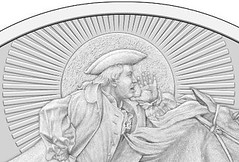 To me, the obverse rays seem to suggest the amplification and dispersion of Revere's voice as he calls out his warning. I didn't see them as a halo but that is a reasonable conclusion.
To me, the obverse rays seem to suggest the amplification and dispersion of Revere's voice as he calls out his warning. I didn't see them as a halo but that is a reasonable conclusion.
Whatever their purpose, I agree that the medal would probably be better off without them. It's a great image of horse and rider and doesn't require embellishment.
I'm curious to see how the final medal looks "in person". That's the ultimate test. Many of us thought the new shield design for the reverse of the 2010 cent was poor, but changed our opinions when seeing the new coins "for real".
I do agree with our reader that the reverse design seems both too busy and too plain. But I wouldn't grade the overall medal so harshly. I still like the obverse enough to give the overall design a B-. -Editor
To read the earlier E-Sylum article, see: 2010 BOSTON ANA MEDAL FEATURES PAUL REVERE (www.coinbooks.org/esylum_v13n24a20.html)
TRUTH IN LABELING NEEDED FOR PRINT ON DEMAND LISTINGS
Last week's New York Times article submitted by Harry Waterson stated that:
"...we're seeing a profusion of digital books - many of them out of copyright - that look new and even 'HD,' but which may well have been supplanted by more accurate editions and better translations."
Joe Boling writes:
Two weeks ago Howard Daniel forwarded a link to a title on Amazon.com - "How to Detect Counterfeit Bank Notes..." by George Peyton. Priced at $11.89 in paperback, I thought it might be a useful text for my summer seminar course on counterfeit paper, so I ordered a copy. I should have noticed the ellipsis in the title.
When it arrived, I discovered that it is a reprint (without the plates, which are essential to the educational value of the work) of the third edition of Peyton's book, the full title of which is "How to Detect Counterfeit Bank Notes: or, An Illustrated Treatise on the Detection of Counterfeit, Altered, and Spurious Bank Notes with Original Bank Note Plates and Designs, by Rawdon, Wright, Hatch & Edson, Bank Note Engravers, of New York."
You will have guessed by now that it was published long ago - in 1861. I already own a first edition (1856). Needless to say, it is completely worthless for my intended use, particularly since no attempt was made to reproduce the plates, even in crude modern reproduction.
No place in any of the listings for this book on Amazon or Abe does it say that it is a print-on-demand copy of a 150-year-old work - or that it is missing four pages of illustrations. If it had been by Laban Heath, I would have known immediately what it was, but George Peyton is not an author whose name sits at the top of my brain.
Yes, we need ways to ascertain what is being offered by the profusion of small presses, and book sellers should be more informative with their listings. I returned the book for a refund, as much to make a point as to get my money back, since I have had to pay for shipping both ways.
To read the earlier E-Sylum article, see: NEW YORK TIMES: FURTHER THOUGHTS OF A NOVICE E-READER (www.coinbooks.org/esylum_v13n24a24.html)
DICK JOHNSON ON HOW THE MERCATOR MAP MEDAL COULD BE REPRODUCED
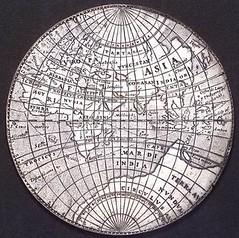 I am familiar with the Mercator Map Medal of 1579. But it was sheer delight to read all the documentation you sent in your recent email.
I am familiar with the Mercator Map Medal of 1579. But it was sheer delight to read all the documentation you sent in your recent email.
In regard to previous authorities' inability to state whether this piece was cast or struck, I can shed a little light but my opinion will not be the final word. It remains for further study, and, perhaps, some scientific analysis.
There are five possibilities of how these pieces were produced:
1. Each hand engraved.
2. Cast from a mold.
3. Die struck.
4. Electrogalvanic cast.
5. Some unknown process.
Each medal hand engraved remains the strongest possibility. Despite the great detail on a 69mm medal, this is easy engraving by flat engraving in contrast to relief engraving required for preparing a die for die striking. As a map publisher, Michael Mercator, would have had access to one or more such hand engravers. The same craftsman who could engrave his printing plates for printing maps could have easily engraved such a medal. Even at this time, 1589, such skilled craftsmanship was not that costly. And whatever time required to complete such a surface engraving for both sides of the medal, was not that great.
Cast from a mold. Once a single specimen was obtained, a mold could have been made, and cast replicas could have been made from this mold. However, these should have shown some casting evidence no matter how small (as nodules near some detail where air bubbles would be lodged). Since none of the descriptions mentions any of this, it is less likely to have been cast.
Die struck. No press existed at this time to have struck a piece this large.
Electrogalvanic casting did not exist at this time. It was not developed until Moritz Herman Jacobi (1801-1874), a German physicist and engineer working in Saint Petersburg Russia developed in 1837 the electrolysis process he called "Galvanoplasty." This technology arrived in London, where the medals were made, in 1840. While the medals could have been made by this technique after this time, if they are all contemporary this possibility is eliminated.
Some unknown process. Possible but slim. A pair of ersatz dies could have been made of iron with a silver blank placed between and some manor of retaining the three parts intact, a great weight could have been applied (in effect, drop forged). How large a weight I cannot speculate. This process produces less finite detail than all previous techniques mentioned.
The quality of the medals leaves me to suggest each were hand engraved by one very experienced hand engraver.
To read the complete article, see: NOTES FROM E-SYLUM READERS: JUNE 6, 2010 (www.coinbooks.org/esylum_v13n23a21.html)
BALDWIN'S TO SELL PART II OF THE MICHAEL HALL MEDAL COLLECTION
Michael Hall has been a prolific collector of art for more than 60 years amassing vast collections with a focus on sculpture. Michael was inspired in his youth by the Kress Collection, a phenomenal collection of medals housed in the National Gallery of Art in Washington that are of artistic importance, not just of historical or archaeological interest. It is therefore unsurprising that the focus of the numismatic part of the Hall collections has always been on the artistic and sculptural aspects of the medals which have augmented his interest in sculpture of all origins and periods.
The aim of the collection is to share the artistic legacy of Europe with the American people, a sentiment which still resonates with Michael. He offers his collection to the public at large with generosity and well meaning and with ‘the hope that you will be as successful as I have been in my most satisfying endeavors.'
The auction of the second part of his collection begins with a large and impressive group of Papal medals from the 15th century onwards, from which highlights include a group of six prize medals of the Accademia di san Luca (lots 1227-1232). Founded in 1593, the academy was setup as an association of artists in Rome for the purpose of elevating the work of “artists”, including painters, sculptors and architects. The image on the reverse of the medals was designed by Giovanni Hamerani in 1694 and was taken from a painting by Guercino. Hamerani came from a family of celebrated artists and engravers and was appointed as medallist to the pope. It has been said he possessed a purer and far superior style to other engravers of his time. Intended as an annual competition, although it was not always the case, these medals were given in three classes and in three disciplines, painting, sculpture and architecture.
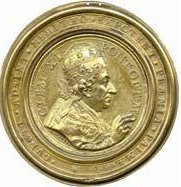
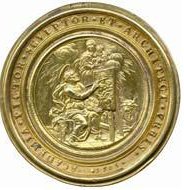
The most significant of the group are lots 1227 (which carries a pre-sale estimate of £800-1200) and lot 1232 (pictured above) which is the only lot to be engraved by Bernhard Perger and has an estimate of £700-900. Other stand out pieces from the section include lots 1245 and 1246, two Clement XII medals. The first is a choice, extremely fine, 1753 Damascened Bronze Complimentary Medal, estimate £300-400 and the second is a 1733 Silver Fountain Medal of San Giovanni in Laterano, estimate £600-800.
The second part of the sale of the Michael Hall Collection of Renaissance and later medals is set to be held by Baldwin's on the 29th June this year in London and the catalogue can be viewed online at www.baldwin.co.uk .
Following on from the outstanding success of part one of the collection this, the second part is a smaller, modest, prelude to the finale due to take place on the 28th September, during London Coinex week. The third and final part of the collection will comprise of northern European Renaissance and later medals.
For more information about The Michael Hall Collection please contact Graham Byfield on +44 (0)20 7930 6879 or at graham@baldwin.co.uk
That's a very good question! As far as I know there is a plan to publish the three catalogues as a hard bound volume, in the same way as we did with the Diana collection, but I think we will take the decision after the final part of the auction once we can gauge demand for it. Hopefully I'll have more info for the third part of the auction.
Many of the medals in this part of the sale are portrait medals, but there are also some nice architectural medals. I've pictured one below.
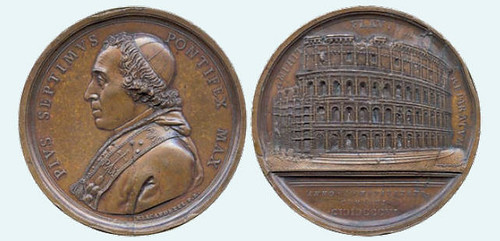
1257 The Restoration of the Colosseum, Copper Medal, 1806, by T Mercandetti, bust left wearing cap, cope and stole, rev façade of the Colosseum, AMPHIT FLAVIVM REPARATVM, 68mm (Patrignani 45; Bartolotti 78; Weber 232).
NOTES FROM E-SYLUM READERS: JUNE 20, 2010
Regarding Tom Kays' review of John Kleeberg's Numismatic Finds book, Megan Fenselau of the American Numismatic Association writes:
What a nice a review in the recent E-Sylum. Unfortunately, the link is incorrect and it mentions a pre-publication sale that ended last year. We've gotten a few inquiries so I just wanted to let you know.
To order a copy of Numismatic Finds at the list price of $125 (or ANS Member price of $87.50), see: www.numismatics.org/Store/FindsOfTheAmericas
To read the earlier E-Sylum article, see: BOOK REVIEW: NUMISMATIC FINDS OF THE AMERICAS BY JOHN KLEEBERG (www.coinbooks.org/esylum_v13n24a07.html)
Bruce Perdue writes:
I spent an interesting evening at the Calumet Numismatic Club in Munster, Indiana. They took advantage of the Central States Numismatic Society's offer to reimburse the club up to $200.00 for a speaker's expenses (one speaker a year per club). The Calumet Club had Mr. Harold Levi speaking on his book, "The Lovett Cent, A Confederate Story".
It was a very interesting Powerpoint presentation. It was particularly interesting to see him utilize Powerpoint to demonstrate the differences between the original pieces and restrikes, copies and fantasies. By moving quickly from one image to another the differences were readily apparent. I sat next to George Corell and got a great introduction to Confederate coins from him.
National Numismatic Collection Senior Curator Dick Doty writes:
As part of next week's Folklife Festival I'll be on the National Mall all day on June 27th. I'll be happy to identify anything anybody brings in, to my best ability.
Tongue-in-cheek, Dick Johnson writes:
I'd like to issue a medal in silver or gold for Campbell Soup Company. It will be the first in a series of bouillon medals.
KENT COMPANY PROTOTYPE COIN BOARDS DISCOVERED
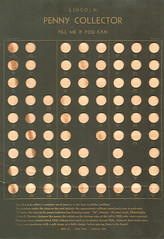 The really big news in CBN #15 is that the Kent Company prototype coin board, previously believed unique and held by a descendant of coin board inventor Joseph K. Post, now has a population of three examples. I acquired the only two known outside of the Post Family during the recent Central States Numismatic Society convention in Milwaukee. These are a part of my own collection and are being kept for study, though one may ultimately be offered for sale.
The really big news in CBN #15 is that the Kent Company prototype coin board, previously believed unique and held by a descendant of coin board inventor Joseph K. Post, now has a population of three examples. I acquired the only two known outside of the Post Family during the recent Central States Numismatic Society convention in Milwaukee. These are a part of my own collection and are being kept for study, though one may ultimately be offered for sale.
This first coin board was an oversize piece for collecting Lincoln Cents that Post devised at his home in 1934 and copyrighted in January of 1935. It was previously believed that none of this type were actually sold to customers, but the two examples which recently surfaced lack the copyright rubber stamping found on the Post Family specimen.
It is thus likely that he did sell a few in or near his hometown of Neenah, Wisconsin and that these extremely rare boards remained within Wisconsin until surfacing in Milwaukee last April. All subsequent Kent Company boards are of the standard 11" x 14" size or very close to it, while this rare variety measures some 17" tall.
For more information, see: www.coincollectingboards.net
QUERY: WHAT IS THIS STRANGE 'GOOD LUCK' SYMBOL?
Regarding the reverse design of the John P. Moore token I pictured a couple issues ago, Stuart Williams writes:
These are all 'good luck' symbols but does anyone know what is the symbol in the lower left quadrant?
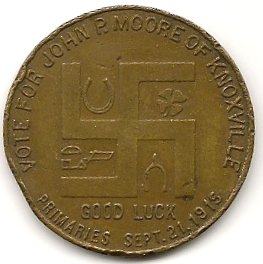
THE BOOK BAZARRE
2010 WORLD CUP COMMEMORATIVE COINS
The world is gaga over the World Cup games, even here in the U.S., where I've heard of one person who arranged two weeks of vacation so he could watch all of the matches he wanted without interference from work. So when ultra-modern numismatist P.K. Saha sent this image of a new World Cup Commemorative Dollar from New Zealand, I thought I'd publish it. There must be dozens of such coins from around the world. I notice that this one is dated 2009. Are funds from sales of these commemorative used to help finance the county's team?
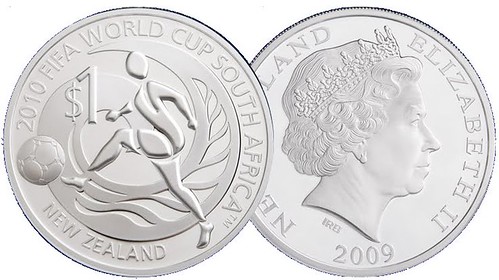
THE WORLD'S LARGEST GOLD COIN TO BE AUCTIONED
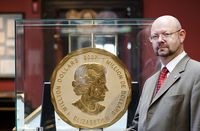 On June 25, 2010, the world's largest gold coin, a 2007 Canadian $ 1,000.000 Maple Leaf is to be auctioned at Vienna's Dorotheum.
On June 25, 2010, the world's largest gold coin, a 2007 Canadian $ 1,000.000 Maple Leaf is to be auctioned at Vienna's Dorotheum.
This coin breaks all records: It weighs a staggering 100 kilos and measures 53 cm in diameter. But the most remarkable thing about this impressive coin, which cannot even be lifted by two men, is that it is made exclusively of the purest, finest and most refined gold: 999.99/1000 gold. The world record-breaking coin, which is also listed in the current edition of the Guinness Book of Records, bears the image of Elisabeth II, the largest official portrait of the Queen in solid gold. The back shows three maple leaves, the national symbol of Canada, where the coin was minted. The face value of $ 1 million is far below the current gold price. The starting price will be based on the daily gold rate.
This gigantic Maple Leaf was on loan to the ‘Münzkabinett' of the Kunsthistorisches Museum in Vienna, which houses one of the largest numismatic collections in the world. The impressive coin has now been entrusted to the Dorotheum. The Dorohteum, the leading auction house in central Europe has been holding important coin auctions with historic coins for more than 200 years. Fittingly, the high-carat coin will come under the hammer at a diamond auction.
To read the complete article, see: The world's largest gold coin to be auctioned at the Dorotheum (www.dorotheum.com/en/auctions/gold-coin.html)
The record-breaking coin had been on loan to a museum in Vienna when its owner, an Austrian investment firm went bankrupt.
Michael Beckers, an auction expert, told the BBC how new methods had to be used to mint the coin.
World's largest gold coin could fetch $4m at auction (news.bbc.co.uk/2/hi/world/europe/10347270.stm)
ARTICLE HIGHLIGHTS BANK OF VANCOUVER SERIAL NO. 1 BANKNOTE
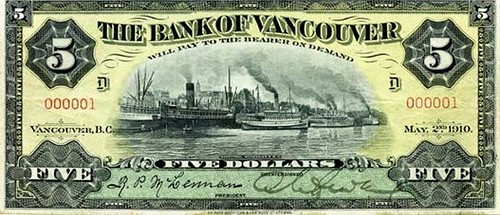
A century after the ill-fated Bank of Vancouver opened, one of its $5 bills is expected to fetch $50,000 to $100,000 at auction.
What makes this $5 bill special is its serial number — 000001. It is literally the first $5 bill issued by the Bank of Vancouver, which operated between 1910 and 1914.
It also doesn't seem to have been ever put into circulation, because it is in excellent shape.
"It's not in mint shape, [but] it's in very fine condition," said Charles Moore of Moore Numismatic Auctions, who will be selling it June 24 in Toronto. "It was folded three times, and appears to have been carried in a wallet. [But] it's in much finer condition than most large-size banknotes of that time."
In fact, Moore thinks it's in the best shape of any of the nine Bank of Vancouver notes that are still known to exist — six fives, two 10s and one 20. Three of the nine are in the National Currency Collection in Ottawa, which means there are only six Bank of Vancouver notes in private hands.
"In October [1914] the Dominion Trust company collapsed after the managing director committed suicide," said Greene. "They were badly hit by the collapse of the real estate speculation. This fellow knew there was no way out, so he committed suicide. At first it was portrayed as an accident, then the trust company didn't reopen. That caused a ripple that really pushed the Bank of Vancouver to the edge."
The Bank of Vancouver issued $5, $10, $20, $50 and $100 bills, in a large format that's 50-per-cent bigger than modern bills. No circulating $50s or $100s are known to still exist, but there are proofs. The rarity of any Bank of Vancouver bills makes them very desirable — a well-worn Bank of Vancouver $5 bill came up for sale in 2008, and sold for $28,500.
Moore expects this one to attract spirited bidding from several collectors, both in Canada and the U.S.
To read the complete article, see:
Bank of Vancouver $5 bill expected to fetch up to $100,000 at auction
(www.vancouversun.com/life/Bank+Vancouver+bill
+expected+fetch+auction/3153650/story.html)
VIDEO: COIN CONNECTED TO ROBERT SCOTT SOUTH POLE EXPEDITION
An E-Sylum reader writes:
This BBC News video briefly recounts the tale behind a gold half sovereign with a connection to history. One of the men on the South Pole expedition of Capt. Robert Scott gave it to a then young child whose family has it today.
 Wales and the Welsh played an important role in financing Captain Scott's expedition to the South Pole, and a century ago a group of people were invited to Cardiff's City Hall, to meet the great adventurer and his team on the eve of their departure.
Wales and the Welsh played an important role in financing Captain Scott's expedition to the South Pole, and a century ago a group of people were invited to Cardiff's City Hall, to meet the great adventurer and his team on the eve of their departure.
Mary Keitch from Penarth, Vale of Glamorgan, has a unique memento from the Scott reception given to her mother, a young girl in 1910.
To read the complete article, see: Coin memento from Captain Scott expedition's farewell (news.bbc.co.uk/2/hi/wales/10324464.stm)
AN INTERVIEW WITH U.S. MINT DIRECTOR EDMUND MOY (PART II)
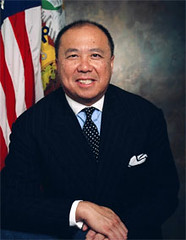 When bullion demand went sky-high, we reached out to our suppliers, the Perth Mint for example, for more planchets (blanks) and many of them almost tripled their production for us. Yet, we still could not keep up with demand, and last year alone, and we sold almost 28 million ounces of silver and gold coins of which about 22 million of which was silver.
When bullion demand went sky-high, we reached out to our suppliers, the Perth Mint for example, for more planchets (blanks) and many of them almost tripled their production for us. Yet, we still could not keep up with demand, and last year alone, and we sold almost 28 million ounces of silver and gold coins of which about 22 million of which was silver.
This was a record amount for us, which made the U.S. Mint the largest producer of bullion coins in the world, and we still could not keep up with the worldwide demand! Legislation requires us to satisfy the demand for bullion related coinage before the collector's version, but it was a tough mandate to have to follow.
MA: Would it have been possible to have this coin minted by the Royal Canadian Mint with a mintmark denoting this? Wouldn't that have been a better alternative to not minting the coin at all?
EM: No, the law stipulates if it is a U.S. coin, it has to be produced in the United States, and only the U.S. Mint can produce legal tender coins. Producing the planchets is not legislated but “stamping” it into a coin is.
MA: With all of the present and potential changes in U.S. coinage, there's a fine line to the right amount of issues for the collector market. Do you think the criticism that the US Mint just issues too many variations of the same coin or too many coins to keep up with is valid?
EM: I am a collector myself, and when I arrived at the Mint, we did have many products I didn't even know about. One of the things I wanted to do, which is an evolving process, is to “whittle down” our portfolio of products. We're producing none of the items we didn't sell and a lot less of those items we sold small amounts of.
We are now saving that production capacity to do two things: One is to make more of those items our collectors want and to make them earlier in the year. The second is to make room for new products. We've found that proof sets, for instance, were being produced in the third quarter of the year and since they are often given as gifts for birthdays and anniversaries, what I want to do is produce those items earlier in the year or even the previous year.
MA: As we conclude, I always ask the question “do you collect coins yourself?” But you've already mentioned that you do. So, I'll ask if you think that makes a difference to the position and products offered when a Mint Director is an active collector.
EM: First, let me tell you how I started. My parents are Chinese immigrants who own Chinese restaurants. One way Chinese culture affects families is they view the family as an economic unit. As soon as I could add, subtract, multiply and divide, my parents put me at the cash register because you trust one of your kids more than an employee.
I remember one customer tried to pay us with an Indian head cent, and I said, “You can't pay us with that!” but looking at it closer, it did say “ONE CENT” on the reverse! This coin made me interested in art and finding out more about Native Americans, and from there I started collecting Indian head cents. That led to collecting Lincoln cents which I found in the restaurant's change and, it just blossomed! I remember when I became Mint Director, my parents asked me when I was going to remove the nine boxes of coins and albums from their home! (Laughs.)
My collection includes Walking Liberty half dollars, Mercury dimes, nice buffalo nickels, and the somewhat controversial Standing Liberty quarters. I'm not too interested in rarities, but really love beautiful designs.
To read the complete article, see: Edmund Moy Interview Part Two: Proof Silver Eagles, U.S. Coin Design (news.coinupdate.com/edmund-moy-interview-part-two-proof-silver-eagles-u-s-coin-design-0328/)
WAYNE'S NUMISMATIC DIARY: JUNE 20, 2010
Most weeks my numismatic activity is pretty much confined to editing The E-Sylum. This week however, I managed to get away for a few hours. Saturday morning I hopped in my new car and drove northward toward Baltimore, site of the Whitman Coin & Currency Expo. I parked in a public garage and walked several blocks thru the Inner Harbor area to the Baltimore Convention Center.
People were milling about the lobby waiting for the doors to open at 10am. The first person I ran into was Julian Leidman. We chatted for a bit. I hadn't seen him in a while. We're both members of my Northern Virginia numismatic social group Nummis Nova, but I'd missed the last few meetings.
Next I spotted Dave Lange in line at the lobby concession stand. We spoke for a while and I thanked him for sending the image of his newest discovery in the coin board field. As the doors opened Dave had to head to his table.
I walked to the back corner of the hall where people were viewing lots for Joe Levine's auction. I sat down at an empty chair in front of Dave Schenkman, another Nummis Nova regular I hadn't seen in a while. As it turn out, sitting in the next chair intently viewing medal lots was John Kraljevich. I'd known John since he was knee-high to a tadpole, and he catalogued many lots in my Civil War and Counterstamp collections when they were sold by American Numismatic Rarities in 2006.
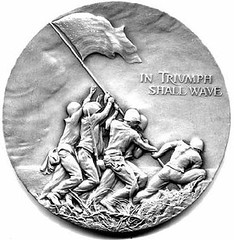 It was good to see him and the three of us chatted and traded banter. I viewed the two Society of Medalists lots I'd profiled in an earlier E-Sylum along with several other great silver SOM medals.
It was good to see him and the three of us chatted and traded banter. I viewed the two Society of Medalists lots I'd profiled in an earlier E-Sylum along with several other great silver SOM medals.
John noted that one of the tokens in the sale was probably identified in one of Dave's many books. He joked that nearly everything had a Schenkman number - "if my cat took a poop on the floor it would be a Schenkman-48!" We laughed and I thought it would be great to use the number as a code word for a crappy token - "Say, that's a nice piece you have there - isn't that a Schenkman-48?"
As I walked the floor I ran into a number of friends, including Paul and Loretta Schultz. I spent a good bit of time at the numismatic literature table of John Burns. He hadn't seen me in so long he had to poke a finger at me to confirm I was real. Also at John's table was Brad Karoleff. We talked about my recent car accident and joked and carried on about a number of topics. Brad told me about the medieval coins he'd bought recently to use in talks to local kids and civic groups.
At the club table for the Liberty Seated Collector's Club I found Len Augsburger and we talked for a good while about the upcoming book on Frank Stewart and the first Philadelphia Mint and other topics. Seated next to Len was E-Gobrecht Editor Bill Bugert, who introduced himself to me. It's always great to put faces to the names of regular E-Sylum pen pals.
Bill was wearing a "Friends of the Hunley" shirt. Turns out he was there the first day the Hunley museum exhibited confederate submarine commander Lt. George Dixon's lucky $20 gold piece, which we've discussed before in The E-Sylum (See HUNLEY SUB LUCKY GOLD COIN FOUND (www.coinbooks.org/esylum_v04n22a05.html)).
As we talked along came Chris Neuzil, another Nummis Nova member. I introduced him to Len and Bill and the four of us chatted for a while. Chris collects early U.S. medals but also has an interest in Bust Halves. He showed us a nice 1810 half he'd purchased at the show.
I stopped briefly at John Kraljevich's table to find yet another Nummis Nova regular, Bill Eckberg. Zelig-like, Brad Karoleff was there, too. I noted that the two of them had the most colorful plumage in the hall - Bill with his bright Hawaiian-style shirt and Brad with his yellow jacket and bright tie. While at the table I viewed a nice copy of Crosby's Early Coins of America with the Nova Constellatio cover.
Next I stopped at the Coin Rarities Online table. I'd never met Dave Wnuck and John Agre, but wanted to thank them for their advertising support for the NBS web site. I introduced myself and had a great time talking about The E-Sylum and all things numismatic. I looked at a Christian Bechtler $2.50 gold coin in their case and told the story of how I acquired one of my best Encased Postage Stamps for a pittance from a Coin World ad.
My last stop on the bourse floor was Wayne Herndon rare coins. Yet another Nummis Nova regular, Wayne showed my pictures of his daughter's high school graduation. She's off to college, and before I know it we'll be sending number one son Christopher off as well. He'll only be 12 in September, but life comes at you fast...
I stepped out to call my wife and grab a quick lunch over at the Inner Harbor. I made it back in time to make the Early American Coppers meeting. Bill was there with (guess - another Nummis Nova regular) Mike Packard of Massachusetts cent fame. It was an enjoyable meeting with about 15 attendees. At the end of the meeting I spoke with Greg Heim and met new E-Sylum subscriber John Saia and his wife.
By then it was time to go. I headed back to Virginia and got home in time for dinner with my family.
 This morning Hannah gave me a nice handmade father's day card that she and her brothers signed. All of us went out after lunch to see a movie - Toy Story 3. It was very enjoyable. After relaxing at home afterwards we went out to a nice dinner. But our big plans are for tomorrow, when we'll head up to Pennsylvania's Hershey Park, leaving the grandparents and Max the Wonder Dog in charge of the house for a couple days.
This morning Hannah gave me a nice handmade father's day card that she and her brothers signed. All of us went out after lunch to see a movie - Toy Story 3. It was very enjoyable. After relaxing at home afterwards we went out to a nice dinner. But our big plans are for tomorrow, when we'll head up to Pennsylvania's Hershey Park, leaving the grandparents and Max the Wonder Dog in charge of the house for a couple days.
Happy Father's Day, Dads!
BIBLIOPULP: PULP FICTION STYLE POSTERS FOR BIBLIOMANIACS
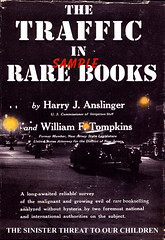

To view all BiblioPulp posters, see: BiblioPulp (www.heldfond.com/bibliopulp.php)
FEATURED WEB SITE: IRISH COINAGE
This week's Featured Web Site is John Stafford-Langan's Irish Coinage site.
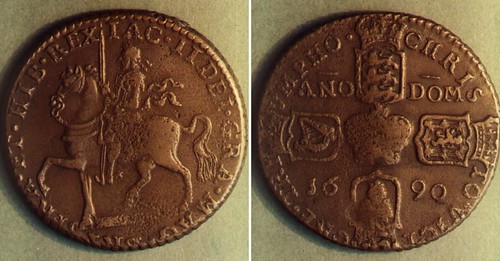
This site first appeared on the World Wide Web on 16/Aug/1994 making it one of the oldest coin sites on the Web. Since then the site has grown considerably with currently over 150 separate pages some of which are very extensive and over 300 images between the in-line images and the high resolution series. In total the site takes about 500 pages of paper to print it out (I haven't tried it all together!) making it a larger reference source of material on Irish coinage than many printed reference books.
www.irishcoinage.com
